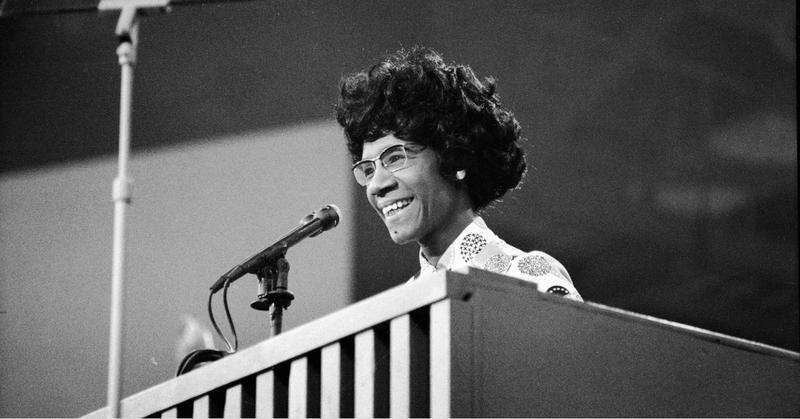Shirley Chisholm: Everything You Didn't Know About The First Black Congresswoman
By | November 16, 2020

As you appreciate the latest political achievements of women of color, take a moment to recognize the glass ceiling– and color barrier–shattering life of Shirley Chisholm, the first black woman to serve Congress in the United States. Her election to the House of Representatives in 1968 came in the midst of the Civil Rights Movement and drew attention to the social limitations imposed on both African-Americans and women.
Brooklyn And Barbados
On November 30, 1924, Shirley Anita St. Hill became the first of four daughters born to immigrants from Barbados who met and wed in New York City in the early 1920s. The long hours the St. Hills worked—Charles St. Hill was a factory laborer and bakery assistant when Chisholm was young, while his wife was a seamstress—made it difficult to raise and educate their children, so when she was just five years old, Chisholm was sent with her sisters to live with their grandmother in Barbados, where she attended a traditional British-style school.
Once she moved back to the United States in 1939, Shirley Chisholm enrolled in an integrated all-girls' high school in Brooklyn that had a reputation as the top school in the borough. She went on to earn a bachelor's degree from Brooklyn College, where she was a member of Delta Sigma Theta sorority and the Harriet Tubman Society, advocated for racial inclusion, and earned awards for her debating skills. After she graduated in 1946, she took a teaching job, later earning a master's degree from Columbia University. In 1949, she married Conrad O. Chisholm, an immigrant from Jamaica.

Politics And Activism
Charles St. Hill actively followed politics, and Shirley learned its nuances from him at an early age through the lively discussions and debates he had with his daughters. As a university student, she showed a keen perception of politics and a passion for activism, and many of her professors urged her to consider making it a career. Chisholm didn't yet believe that a black woman in America could have any success in the field, but that didn't completely stop her from lending her support to the causes of racial and gender equality. She joined the National Association for the Advancement of Colored People, the Urban League, the League of Women Voters, and the Brooklyn Democratic Party Club.
In 1962, she campaigned for Thomas R. Jones in his bid to become Brooklyn's second black assemblyman, but when Jones decided not to seek reelection and accept a judicial appointment instead, she ran for his seat and won. She served as a member of the New York State Assembly from 1965 to 1968, during which time she pushed to repeal the state's requirement for voters to pass an English literacy state, convinced the legislature to include domestic workers in unemployment benefits, and initiated programs to help disadvantaged students get into college.

"Unbossed And Unbought"
In January 1968, Chisholm announced her intention to run for the United States House of Representative in New York's 12th congressional district. Her campaign slogan, "Unbossed and Unbought," not only called attention to her strength, intelligence, and independence, it insinuated that other candidates were under the thumb of lobbyists.
In the primary election, Chisholm beat two other black candidates, State Senator William S. Thompson and labor official Dollie Robertson, to the November ballot, and on Election Day, she won her race with Liberal Party candidate and former director of the Congress of Racial Equality James Farmer. The victory made her not only the first black woman elected to Congress but, in fact, the only woman in that year's congressional freshman class.
Upon joining Congress, Chisholm was assigned to serve on the House Forestry Committee, and although she believed in the importance of environmental protection, she was disappointed. She hoped to continue her work with issues of gender and racial equality. In a bold and shocking move, Chisholm demanded to be reassigned to a committee better suited to her background and experience. Her request was granted, and she was moved to the Veterans' Affairs Committee.

A Bid For The Presidency
Chisholm served seven consecutive terms in the House of Representatives, during which time she moved from the Veterans' Affairs Committee to the Education and Labor Committee. She tirelessly championed the promotion of educational and employment opportunities for minorities, and she was one of the founding members of the Congressional Black Caucus, formed in 1969.
On January 25, 1972, Chisholm officially announced her candidacy for President of the United States, making her the first black major party presidential candidate and the first woman to run for the Democratic Party nomination. Chisholm's campaign lacked the financial backing that other candidates enjoyed, however, and she faced a wave of discrimination. She was banned from participating in televised primary debates and only permitted to make one televised speech after filing and winning a lawsuit. Her gender even cost her the wholehearted support of the Congressional Black Caucus. In the end, Chisholm made a respectful showing, but it wasn't enough to earn her party's nomination.

Shirley Chisholm's Later Life
Chisholm divorced her husband in early 1977 and married one-time New York State Assemblyman Arthur Hardwick, Jr. later that year, retiring from Congress five years later after he was severely injured in a car accident. She cared for him until his death in 1986 and went on to survive him another 20 years, passing away on New Year's Day 2005. Prior to her death, she stated, "I want to be remembered as a woman who dared to be a catalyst of change."

